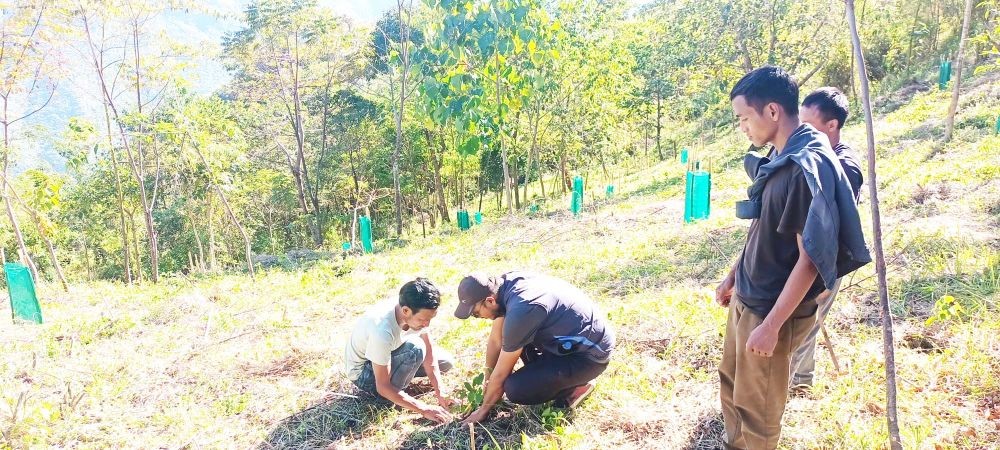Members of Changlangshu Biodiversity Management Committee are seen planting native trees on a empty patch of land. The Committee aims to connect three small scattered patches of forest into one intake forest which will create a green corridor for wildlife. (Morung Photo: By Special Arrangement)

Around 2000-2500 native trees planted so far
Vibi Yhokha Sophie
Kohima | April 27
It was through his Green Hub Fellowship programme - a programme on environment, wildlife, conservation and climate sustainability through filmmaking- that Wanmei Konyak first developed the passion to work for the environmental cause.
On return to his native Changlangshu village, he, along with nine other, formed the Changlangshu Biodiversity Management Committee (CBMC) in 2018 to start a forest restoration initiative in his village.
Each year, the CBMC organises two plantation drives during the monsoon season where indigenous tree species saplings are planted.
Weed clearing is conducted three times annually along with the construction of tree guards, pruning, and manure for protection and identification. The team also maintains monthly monitoring at the restoration site to check the rate of growth.
“So far, we have planted at least 2000-2500 native trees. Another first plantation drive for the current year will be carried out later next month at the restoration site with a target of 600-700 saplings,” informed Konyak.
While scientific measurements of the area have not been conducted, the Committee has covered approximately 3 hectares plantation area.
The main goal of the initiative, according to Konyak, was to connect three small scattered patches of forest into one intake forest which will create a green corridor for wildlife.
“Many migratory birds also visit this site for rest as it lies in the hill top. So, once we restore the gap areas (jhum land) and connect these small patches of forest there is hope that both forest and wildlife will flourish again,” shared Konyak.
‘No mean task’
The restoration efforts, however, has not been easy for the eco-warriors. After seeking consent from the Village Council, the Committee was registered in the Nagaland State Biodiversity Board.
The first problem was with the Naga land ownership where most lands and forests are owned by the clan or individuals.
Following, consultations and negotiations with the traditional land and forest owners, the areas were declared area as a community reserve forest.
“The other challenge was rampant hunting of wildlife for bushmeat. It was difficult to impose complete ban on hunting but through the Students' Union, we were able to ban hunting for six months during breeding season and impose total ban of hunting at the restoration areas and reserved forest,” Konyak noted.
Noticing the efforts and dedication towards the environment and wildlife conservation, the Changlangshu community started extending support to the team.
“Last year, two families donated two jhum areas for restoration which was a great achievement for us. It is where we've started proper restoration works,” Konyak said.
“We have a small reserve forest which is called Eaknyak and the other restoration area is called Takshoak. Both are connected. In future if the restoration is successful, it will become part of the reserve forest,” he added.
Today, Changlangshu BMC has more than 30 members working in the restoration efforts along with the support of the community and outsiders whenever larger activities are organised.
Other initiatives
“We also try to engage our youths when we organize any restoration work and eventually those who joined regularly in the activities become a member. While, the other responsibilities such as work plan, meeting with the village council and traditional land owner, financial matter etc. is look after by the BMC executives,” maintained Konyak.
While restoration is their long term goal, the Committee is also engaged in other initiatives. Another significant initiative is the setting up of a Nursery and Herbal garden at the Changlangshu Primary Health Centre which is monitored weekly.
In future, the Committee looks forward to promoting eco-tourism which will engage and empower the community especially the traditional land ownership local youths and students.
“The community can benefit from home stays, traditional land owner can make benefit from entry fees, local youths can become tourist guides and students can make use of this site for nature walk or bird watching. These are some of our goals which we wanted to achieve soon once we get support from government or private agencies,” opined Konyak.
While it is early to say who or how much the community will benefit, Konyak is hopeful that the Committee is building back a better future for Changlangshu.






